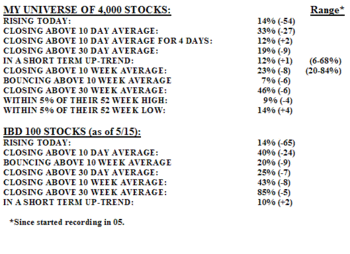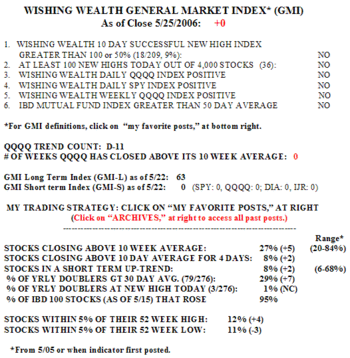The GMI remains at zero, in spite of the strength last week. On Friday, 63% of the Nasdaq 100 stocks rose, as did 73% of the S&P 500 stocks and 87% of the Dow 30 stocks. 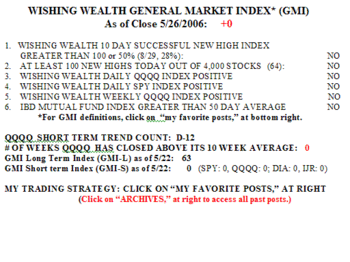 However, there were only 28% (8/29)successful 10 day new highs–stocks that hit a new high 10 days ago and closed higher on Friday than they did 10 days before. In addition, there were only 64 new yearly highs in my universe of 4,000 stocks. None of my 16 short term indicators for the SPY, DIA, QQQQ and IJR were positive–GMI-S= 0, and the GMI-L = 63. Friday was the 12th day of the current short term down trend in the QQQQ.
However, there were only 28% (8/29)successful 10 day new highs–stocks that hit a new high 10 days ago and closed higher on Friday than they did 10 days before. In addition, there were only 64 new yearly highs in my universe of 4,000 stocks. None of my 16 short term indicators for the SPY, DIA, QQQQ and IJR were positive–GMI-S= 0, and the GMI-L = 63. Friday was the 12th day of the current short term down trend in the QQQQ.
I expanded the comparison of my indicators to include the IBD 100 stocks. 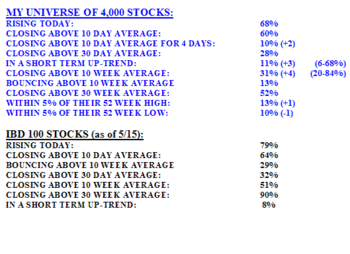 I think it will provide valuable insights into the market to see how the highly rated IBD100 stocks’ performance compares with my universe of 4,000 stocks. On Friday, 68% of the stocks in my universe advanced, compared with 79% of the IBD 100 stocks. About the same percentages of stocks closed above their short term 10 day and 30 day averages. 8%-11% were in a short term up trend. Major differences appeared in the longer term indicators, however. Thus, 31% of my universe of stocks closed above their 10 week averages while 51% of the IBD 100 stocks did. 90% of the IBD 100 stocks closed above their 30 week averages, but only 52% of my universe of stocks did. Finally, twice as many IBD 100 stocks bounced above their 10 week averages last week (29% vs. 13%). These differences are important and signify that the IBD 100 type of growth stocks are more likely to remain in longer term up trends and almost one third found support last week at their 10 week averages. As long as these stocks hold above their 10 and 30 week averages, growth stocks remain in longer term up trends…….
I think it will provide valuable insights into the market to see how the highly rated IBD100 stocks’ performance compares with my universe of 4,000 stocks. On Friday, 68% of the stocks in my universe advanced, compared with 79% of the IBD 100 stocks. About the same percentages of stocks closed above their short term 10 day and 30 day averages. 8%-11% were in a short term up trend. Major differences appeared in the longer term indicators, however. Thus, 31% of my universe of stocks closed above their 10 week averages while 51% of the IBD 100 stocks did. 90% of the IBD 100 stocks closed above their 30 week averages, but only 52% of my universe of stocks did. Finally, twice as many IBD 100 stocks bounced above their 10 week averages last week (29% vs. 13%). These differences are important and signify that the IBD 100 type of growth stocks are more likely to remain in longer term up trends and almost one third found support last week at their 10 week averages. As long as these stocks hold above their 10 and 30 week averages, growth stocks remain in longer term up trends…….
While the markets have bounced and many growth stocks are holding up, there have been many declines in other stocks. I scanned the market for stocks that appear to be breaking down. If the market continues to weaken this week, I will research buying puts on the following stocks: RECN, PSUN, KOSP, RTSX, OXM, NMTI, WBSN and CMX. All of these have had some high volume down weeks since reaching peaks several months ago. All are below their 10 week averages and their declining 10 week averages are below their 30 week averages…
I asked some friends about what it was like this weekend in Ocean City, on Maryland’s eastern shore. The place should have been inundated with tourists–it was not. I also talked with a real estate agent there who said there was a huge inventory of houses and condos that were not selling. If other hot vacation markets are as weak, we may be seeing the effects of high gas prices and high interest rates. Maybe the Fed will decide to pause as these trends become evident………
Please send your comments to: silentknight@wishingwealthblog.com.
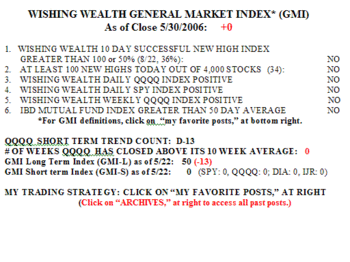 On Tuesday, none of the Dow 30 stocks advanced, but 9% of the S&P 500 stocks did along with 10% of the Nasdaq 100 stocks. My universe of 4,000 stocks and the IBD 100 stocks each did a little better, with 14% gaining. There were 8/22 successful 10 day new highs but 73/116 successful 10 day new lows. Shorting and holding new lows 10 days ago was much more likely to be profitable than buying and holding new highs. There were 34 new highs and 60 new lows on Tuesday. Tuesday was the thirteenth day (D-13) in the current short term down trend in the QQQQ.
On Tuesday, none of the Dow 30 stocks advanced, but 9% of the S&P 500 stocks did along with 10% of the Nasdaq 100 stocks. My universe of 4,000 stocks and the IBD 100 stocks each did a little better, with 14% gaining. There were 8/22 successful 10 day new highs but 73/116 successful 10 day new lows. Shorting and holding new lows 10 days ago was much more likely to be profitable than buying and holding new highs. There were 34 new highs and 60 new lows on Tuesday. Tuesday was the thirteenth day (D-13) in the current short term down trend in the QQQQ. 